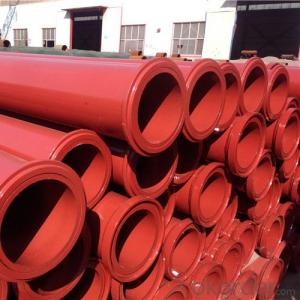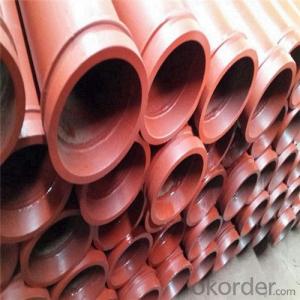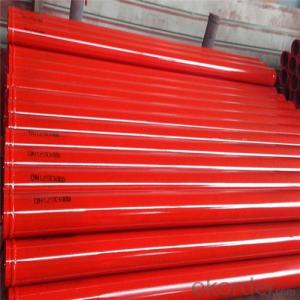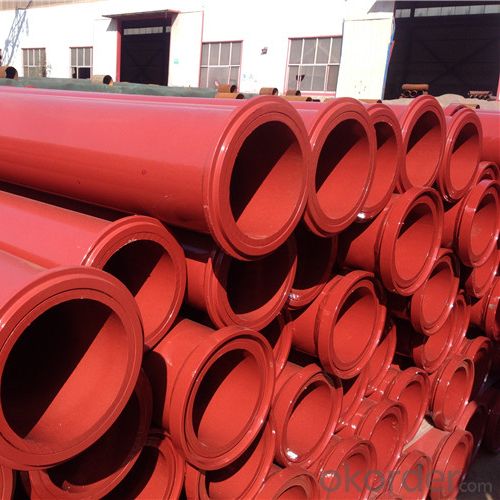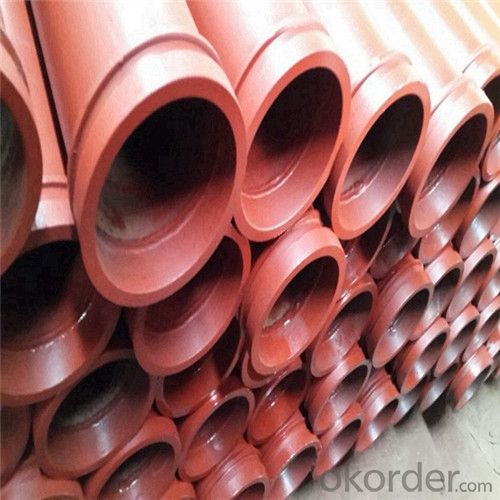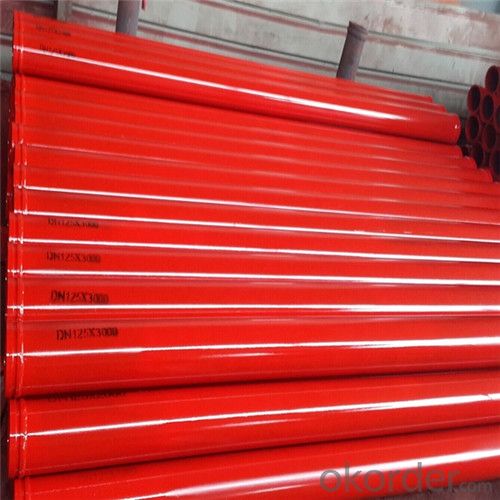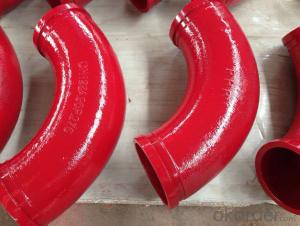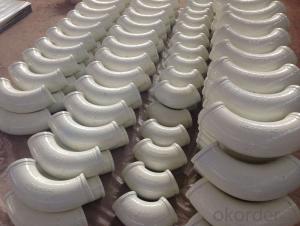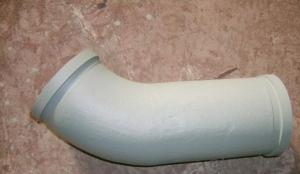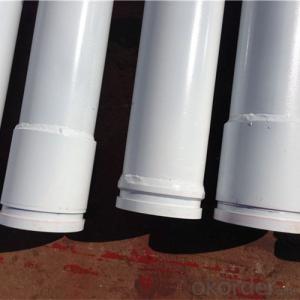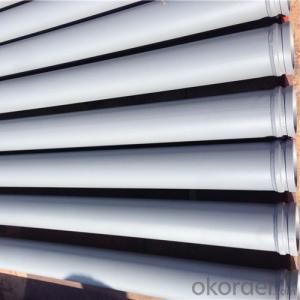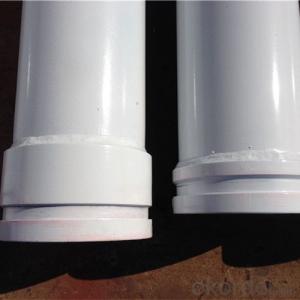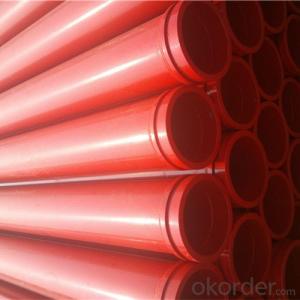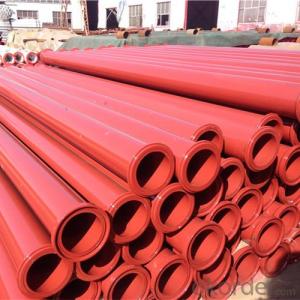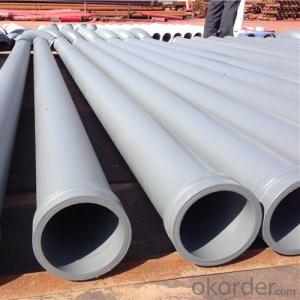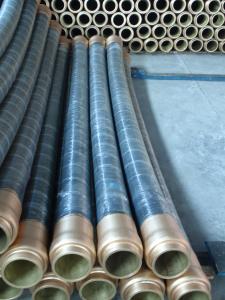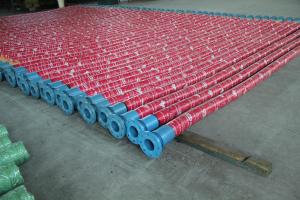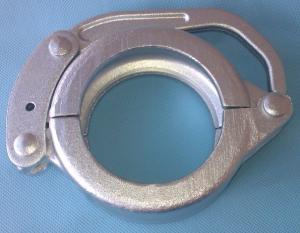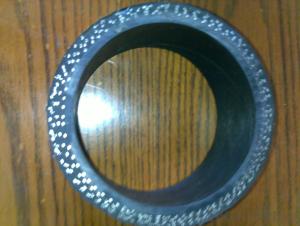3M Seamless Delivery Pipe for Concrete Pump Thickness 4.0mm
- Loading Port:
- Tianjin
- Payment Terms:
- TT or LC
- Min Order Qty:
- 50 pc
- Supply Capability:
- 5000 pc/month
OKorder Service Pledge
OKorder Financial Service
You Might Also Like
3M Seamless Delivery Pipe for Concrete Pump Thickness 4.0mm
1. Structure of 3M Seamless Delivery Pipe for Concrete Pump Thickness 4.0mm:
St52 Seamless Pipe: Now More People like use this kind for Truck Pump and Trailer Pump because of the quality is better and it is seamless kind, so this kind pipe is most popular in Middle East Price About 34USD-37USD.
Wear Resistant Pipe: Use for Truck Pump, Wear Resistant Layer is 2.5mm.Through heat treatment way make this pipe more strong (HRC60-62), Using Life: 25,000m³-35,000m³ Price about 65USD-68USD.
Two Wall Pipe: This pipe thickness (2mm+2.5mm), Using Life about 50,000m³-60,000m³
2. Main Features of 3M Seamless Delivery Pipe for Concrete Pump Thickness 4.0mm:
• High Wear-resistant, long service life, lower cost
• In case of quality problem the company provide free replacement.
• Our company passed the ISO9000 certification, the product through 3C certification in full compliance with national standards
3. 3M Seamless Delivery Pipe for Concrete Pump Thickness 4.0mm Images
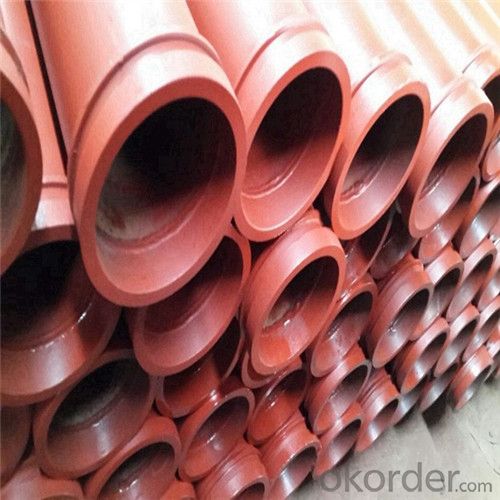
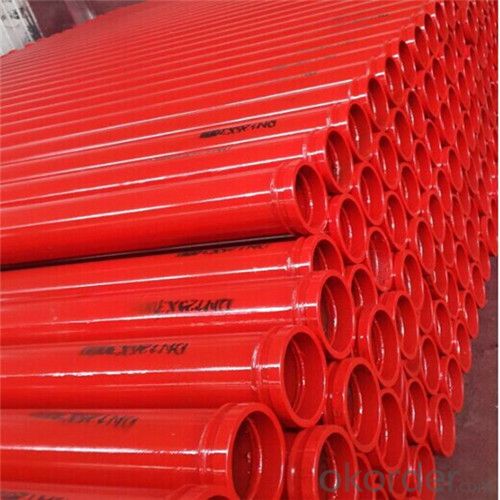
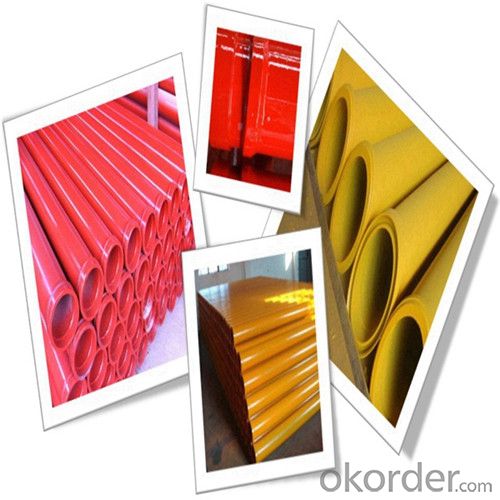
4. 3M Seamless Delivery Pipe for Concrete Pump Thickness 4.0mm Specification
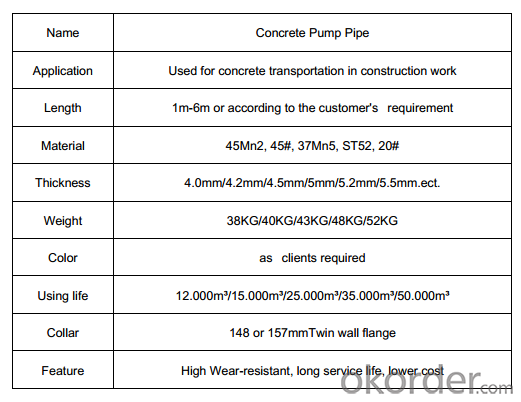
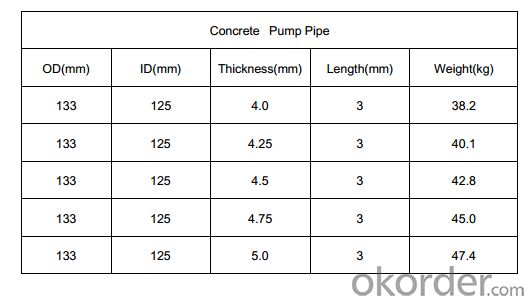
Production Process
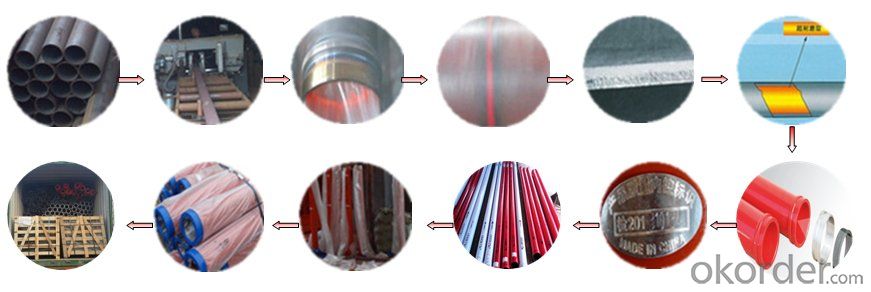
5. FAQ
We have organized several common questions for our clients, may help you sincerely:
①Is your products exported a lot?
We have exported to many, many countries. Every year we ship more than 30 containers of these spare parts. Our main market is in Middle-east, Asia & Africa.
②How to guarantee the quality of the products?
We have established the international advanced quality management system,every link from raw material to final product we have strict quality test;We resolutely put an end to unqualified products flowing into the market. At the same time, we will provide necessary follow-up service assurance.
- Q: Are there any cost-effective alternatives to original concrete pump spare parts?
- Indeed, there exist cost-effective alternatives to the original spare parts for concrete pumps. One possibility is to contemplate acquiring aftermarket parts, which are frequently manufactured by third-party producers. These components are engineered to meet identical specifications and criteria as the original parts, yet they are commonly obtainable at a reduced price. Another avenue to explore is the acquisition of used or refurbished parts. These parts have previously been employed but have been refurbished to function flawlessly, presenting a more economical substitute for new parts. Nevertheless, it is crucial to verify that these alternatives are obtained from trustworthy suppliers to guarantee quality and compatibility with the particular model of your concrete pump.
- Q: How often should hopper grate clamps be inspected or replaced in a concrete pump?
- Regular inspections of hopper grate clamps in a concrete pump are essential to ensure they are functioning correctly. It is recommended to inspect them on a monthly basis. However, the frequency of inspection may vary based on how frequently the pump is used and the operating conditions it is subjected to. If the concrete pump is used extensively or exposed to harsh environments, more frequent inspections may be needed, such as every two weeks or even weekly. Conversely, if the pump is used infrequently or operates in less demanding conditions, inspections can be done less frequently, such as every two to three months. The objective of these inspections is to detect any signs of wear, damage, or deterioration in the hopper grate clamps. Any loose or worn-out clamps should be replaced promptly to prevent accidents or interruptions during concrete pumping operations. Ensuring the hopper grate clamps are in good condition is crucial for safety and to effectively secure the hopper grate, preventing any undesired material spillage. By conducting regular inspections and timely replacements of hopper grate clamps, the efficiency and reliability of the concrete pump can be maintained. This will ensure uninterrupted operation and minimize the risk of potential issues.
- Q: Are there any specific guidelines for the installation of pipe or hose assemblies in concrete pump spare parts?
- Yes, there are specific guidelines for the installation of pipe or hose assemblies in concrete pump spare parts. These guidelines ensure proper installation techniques are followed to ensure the assemblies are securely and correctly installed. It is important to consult the manufacturer's instructions and adhere to industry standards to ensure optimal performance and safety of the concrete pump spare parts.
- Q: How often should I replace concrete pump spare parts?
- The frequency of replacing spare parts for concrete pumps is determined by several factors, including the quality of the parts, how frequently they are used, and regular maintenance. It is generally recommended to regularly inspect and maintain the spare parts to detect any signs of wear or damage. As a precautionary measure, it is advisable to replace parts that display significant wear or are no longer functioning optimally. However, it is essential to adhere to the manufacturer's guidelines and recommendations for the specific model of concrete pump being used. Additionally, seeking advice from experienced professionals or technicians in the field can offer valuable insights into the expected lifespan of different spare parts and when replacements may be required.
- Q: Can I get spare parts for both concrete pumps with and without boom control systems?
- Yes, you can typically get spare parts for both concrete pumps with and without boom control systems. Many manufacturers and suppliers of concrete pumps offer a wide range of spare parts to meet the needs of different types of pumps. Whether it's for a pump with a boom control system or one without, you should be able to find the necessary spare parts from reputable suppliers. It is recommended to contact the manufacturer or supplier directly to inquire about the availability and compatibility of spare parts for your specific concrete pump model.
- Q: Can concrete pump spare parts be installed by the pump owner or operator, or is professional assistance required?
- Professional assistance is generally required for the installation of concrete pump spare parts. The complexity and technical nature of these parts, along with the potential safety risks involved, necessitate the expertise of trained professionals. Attempting to install the spare parts without proper knowledge and experience could lead to improper functioning of the pump and even accidents. It is always recommended to seek professional assistance to ensure the correct installation and safe operation of concrete pump spare parts.
- Q: How can one store and handle concrete pump spare parts to maintain their quality?
- To maintain the quality of concrete pump spare parts, it is crucial to store and handle them properly. Firstly, these spare parts should be stored in a clean and dry environment, away from moisture and direct sunlight. They should also be protected from dust and debris by using suitable covers or packaging. Additionally, it is important to handle them with care, avoiding any rough or improper handling that could cause damage. Regular inspection and maintenance of the spare parts should also be conducted to identify any signs of wear or corrosion, ensuring they are in optimal condition when needed for use.
- Q: How do I properly maintain and replace hydraulic motors in concrete pump spare parts?
- Proper maintenance and replacement of hydraulic motors in concrete pump spare parts is crucial to ensure the smooth operation and longevity of the equipment. Here are some steps to guide you in maintaining and replacing hydraulic motors effectively: 1. Regular Inspection: Perform routine inspections of the hydraulic motors to identify any signs of wear, damage, or leaks. Check the fluid levels and ensure they are at the recommended levels. 2. Cleanliness: Keep the hydraulic motors clean by removing any dirt, debris, or contaminants. This helps prevent the motors from overheating and minimizes the risk of damage to the internal components. 3. Fluid Maintenance: Regularly check and change the hydraulic fluid according to the manufacturer's recommendations. Clean and replace the filters to ensure the fluid is free from any particles that can cause damage to the motors. 4. Lubrication: Lubricate the hydraulic motors as per the manufacturer's instructions. This helps reduce friction and wear on moving parts, improving the overall performance and lifespan of the motors. 5. Proper Usage: Operate the concrete pump within the recommended load and pressure limits specified by the manufacturer. Overloading or excessive pressure can cause stress on the hydraulic motors, leading to premature failure. 6. Timely Replacement: Keep track of the service life and usage of the hydraulic motors. Over time, these motors may wear out and become less efficient. Replace them promptly when necessary to prevent any disruption to the concrete pumping operations. 7. Seek Professional Assistance: If you are unsure about maintaining or replacing hydraulic motors, it is advisable to seek professional assistance. They have the expertise and knowledge to carry out the necessary tasks correctly, ensuring the safety and optimal performance of the concrete pump spare parts. By following these steps, you can properly maintain and replace hydraulic motors in concrete pump spare parts, ensuring the longevity and efficiency of your equipment.
- Q: What is the purpose of a concrete pump cylinder?
- The purpose of a concrete pump cylinder is to provide the necessary pressure and force to transport and deliver concrete from the pump to the desired location. The cylinder is an essential component of a concrete pump, as it allows for the efficient movement of concrete through the pump system. The cylinder works by using hydraulic pressure to push the concrete through the pipeline, ensuring a continuous and smooth flow of concrete. It plays a crucial role in construction projects, enabling concrete to be precisely and efficiently placed in various locations, such as buildings, bridges, or other structures. By providing the necessary power and pressure, the concrete pump cylinder ensures that concrete can be transported over long distances, vertically or horizontally, with minimal effort and labor. Overall, its purpose is to facilitate the efficient and precise delivery of concrete, saving time and effort in construction projects.
- Q: What are the types of concrete pumps?
- According to the structure and use of divided into drag type concrete pump, car pump and pump car
Send your message to us
3M Seamless Delivery Pipe for Concrete Pump Thickness 4.0mm
- Loading Port:
- Tianjin
- Payment Terms:
- TT or LC
- Min Order Qty:
- 50 pc
- Supply Capability:
- 5000 pc/month
OKorder Service Pledge
OKorder Financial Service
Similar products
Hot products
Hot Searches
Related keywords
